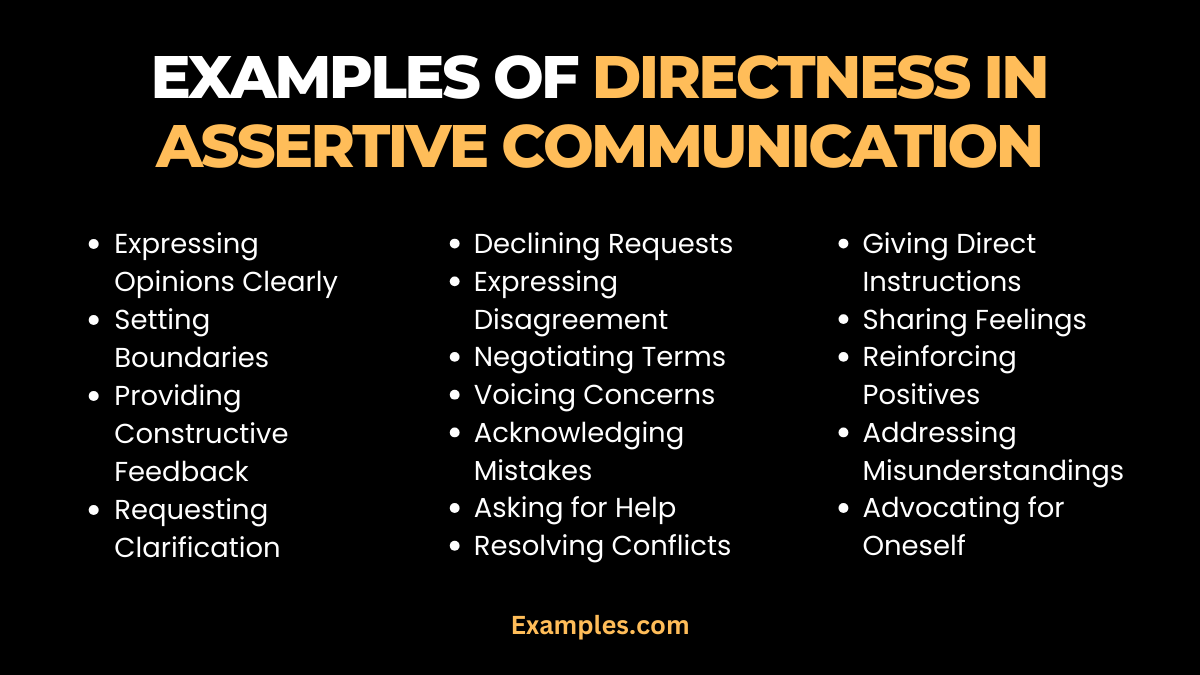14+ Directness in Assertive Communication Examples
Delve into the realm of Directness in Assertive Communication with this comprehensive guide. Packed with practical communication examples, it unlocks the secrets to expressing oneself clearly and confidently without being aggressive. From workplace conversations to personal discussions, mastering this skill is crucial for anyone looking to communicate their needs and opinions effectively while maintaining respect and understanding. This guide is your roadmap to assertive communication, empowering you to navigate various interactions with poise and assurance.
What is Directness in Assertive Communication?

Directness in assertive communication is the skill of expressing one’s thoughts, feelings, and needs openly and honestly, while respecting others. It involves clear, straightforward communication that is neither aggressive nor passive. This approach fosters mutual respect and understanding in interactions, making it a vital component of effective communication.
15 Examples of Directness in Assertive Communication

- Expressing Opinions Clearly: State your views openly and respectfully.
Example: “I believe we should reconsider our strategy to improve efficiency.”

- Setting Boundaries: Communicate your limits firmly but politely.
Example: “I can’t take on extra work this week due to prior commitments.” - Providing Constructive Feedback: Offer honest, helpful feedback in a respectful manner.
Example: “Your report was well-written, but adding more data would enhance its impact.” - Requesting Clarification: Ask for more information when things are not clear.
Example: “Can you elaborate on this point for better understanding?” - Declining Requests: Say no without feeling guilty and without being rude.
Example: “I appreciate the offer, but I must decline due to other priorities.” - Expressing Disagreement: Disagree in a way that is direct but respectful.
Example: “I see things differently. Let’s explore other possible solutions.” - Negotiating Terms: Negotiate assertively, aiming for a win-win situation.
Example: “Let’s find a compromise that benefits both parties.” - Voicing Concerns: Raise issues or concerns in a straightforward, non-confrontational manner.
Example: “I have some concerns about this plan that I’d like to discuss.” - Acknowledging Mistakes: Admit errors openly and take responsibility.
Example: “I made a mistake in the calculation, and I’m correcting it now.”

- Asking for Help: Request assistance clearly without downplaying your needs.
Example: “I need help with this task to meet the deadline effectively.” - Giving Direct Instructions: Provide clear, concise directions or instructions.
Example: “Please complete the report by Friday with all the necessary details.” - Sharing Feelings: Communicate your emotions honestly and appropriately.
Example: “I feel overwhelmed by the current workload.” - Reinforcing Positives: Acknowledge and reinforce positive behaviors or outcomes.
Example: “Your contribution to the project made a significant difference.” - Addressing Misunderstandings: Clear up misunderstandings directly and calmly.
Example: “There seems to be a misunderstanding; let me clarify my point.” - Advocating for Oneself: Stand up for your own needs and interests.
Example: “I believe I deserve this opportunity based on my performance.”
Importance of Directness in Assertive Communication
- Enhances Clarity: Directness in assertive communication eliminates ambiguity, ensuring that the message is clear and understandable.
- Builds Trust: Being direct and honest fosters trust in personal and professional relationships.
- Improves Decision Making: Clear communication enables better and quicker decision-making, as all parties understand the situation accurately.
- Reduces Conflict: Direct communication minimizes misunderstandings that can lead to conflicts.
- Promotes Efficiency: Directness leads to more efficient communication, saving time and preventing confusion.
- Strengthens Relationships: It encourages open and honest interactions, which are crucial for strong, healthy relationships.
- Facilitates Problem Solving: Direct communication is essential in identifying and addressing issues effectively.
- Increases Influence: A direct approach in communication often persuades and influences others more effectively.
- Encourages Authenticity: Being direct allows individuals to express their true thoughts and feelings.
- Supports Personal Boundaries: Directness helps in clearly establishing and maintaining personal boundaries.
Role of Directness in Assertive Communication
- Conveys Confidence: Directness in assertive communication demonstrates confidence and self-assuredness.
- Ensures Understanding: It guarantees that the intended message is conveyed and understood as intended.
- Supports Leadership: Direct communication is a key trait of effective leadership, guiding teams with clarity.
- Enhances Professional Image: In professional settings, directness contributes to a perception of competence and reliability.
- Aids in Conflict Resolution: It plays a crucial role in resolving disagreements by addressing issues head-on.
- Facilitates Feedback: Direct communication is vital in giving and receiving constructive feedback.
- Promotes Honesty: It encourages a culture of honesty and openness in various settings.
- Improves Negotiation Skills: Being direct is essential in negotiations, as it leads to clearer outcomes.
- Encourages Others to Be Open: Direct communication often inspires others to be open and straightforward.
- Supports Personal Development: It helps individuals in self-assertion and personal growth.
In summary, this guide highlights the pivotal role of directness in assertive communication. Directness not only clarifies and streamlines communication but also builds trust, fosters efficiency, and strengthens relationships. By embracing directness, individuals and professionals can communicate more effectively, influence decisions, and resolve conflicts with greater ease. This guide offers valuable insights and tips for incorporating directness into everyday communication, enhancing both personal and professional interactions.



